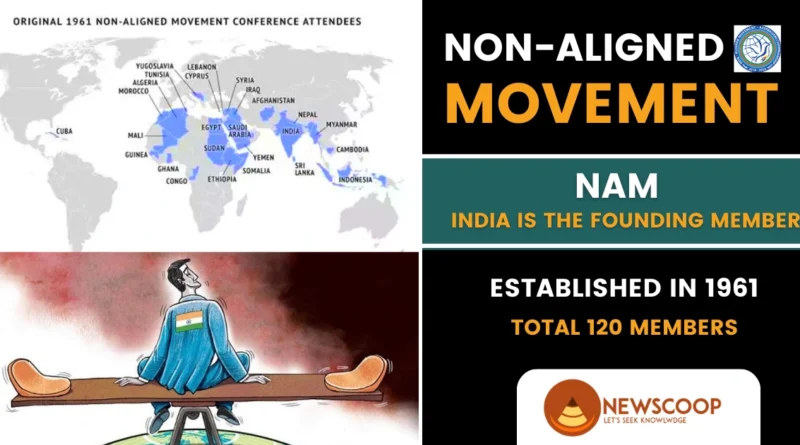Non-Aligned Movement: Objectives & Membership
The Non-Aligned Movement (NAM) is a significant international organization consisting of 120 member states, primarily from the Global South.
It was established in 1961 during the height of the Cold War as a platform for countries that did not want to align themselves with either the Western bloc led by the United States or the Eastern bloc led by the Soviet Union.
History & Background of the Non-Aligned Movement (NAM)
The Non-Aligned Movement (NAM) emerged as a significant international organization during the Cold War era. Its history and background can be traced back to the period following World War II and the subsequent decolonization wave that swept across many nations. Here is a detailed exploration of the history and background of the Non-Aligned Movement.
Post-World War II Decolonization & Cold War Polarization
The end of World War II marked a significant shift in the global political landscape, with the dismantling of colonial empires and the emergence of newly independent nations. Many of these newly independent countries found themselves caught between the competing ideological and geopolitical spheres of influence represented by the two superpowers of the time—the United States and the Soviet Union.
The Cold War, characterized by the ideological standoff between capitalism and communism, led to the division of the world into two blocs—the Western bloc led by the United States and its allies, and the Eastern bloc led by the Soviet Union and its allies. This polarization created a challenging dilemma for newly independent nations, as aligning with either bloc often came with conditions and limitations on their sovereignty.
The Birth of the Non-Aligned Movement
The Non-Aligned Movement originated from the Bandung Conference held in 1955 in Bandung, Indonesia. The conference brought together leaders from 29 African and Asian countries, including Jawaharlal Nehru of India, Gamal Abdel Nasser of Egypt, and Sukarno of Indonesia. The Bandung Conference aimed to address the challenges faced by newly independent nations and forge a united front against colonialism, racism, and imperialism.
During the conference, the idea of non-alignment began to take shape. The participating nations expressed their commitment to pursue an independent foreign policy, free from the influence of the major power blocs. They sought to establish a middle ground and distance themselves from the Cold War rivalry while advocating for principles such as self-determination, national sovereignty, and non-interference in the internal affairs of other states.
The Belgrade Conference & Formation of NAM
The concept of non-alignment gained further momentum with the Belgrade Conference held in 1961 in Belgrade, Yugoslavia (now Serbia). The Belgrade Conference brought together leaders from 25 countries, including Josip Broz Tito of Yugoslavia, Jawaharlal Nehru of India, and Kwame Nkrumah of Ghana.
During the conference, the leaders formalized the non-aligned stance and laid the groundwork for the establishment of the Non-Aligned Movement. They issued the Belgrade Declaration, which outlined the principles and objectives of the movement. The NAM was officially founded as an organization with its headquarters in Belgrade.
Expansion & Development of NAM
Following its establishment, the Non-Aligned Movement experienced significant growth in membership. More countries from Africa, Asia, and Latin America joined the movement, expanding its global representation. The NAM provided a platform for member nations to share experiences, cooperate on various issues, and amplify their voices on the global stage.
Over the years, the NAM played a vital role in advocating for decolonization, promoting disarmament, addressing economic inequality, and voicing the concerns and aspirations of the Global South. The movement actively participated in international forums such as the United Nations and the Non-Aligned Summits, where leaders discussed and coordinated positions on global issues.
Membership of the Non-Aligned Movement (NAM)
The Non-Aligned Movement (NAM) is an international organization that consists of a diverse membership of countries from various regions across the globe. The membership of NAM has evolved since its establishment and currently includes numerous member countries. Here is an overview of the membership of the Non-Aligned Movement:
Founding Members of Non-Aligned Movement
Some of the founding members of the Non-Aligned Movement (NAM) include:
- India
- Yugoslavia
- Egypt
- Ghana
- Indonesia
Current Membership
As of now, the Non-Aligned Movement comprises 120 member countries. These countries come from different regions and encompass a wide range of political systems, levels of development, and strategic interests. The membership of NAM includes the following:
- Africa: The majority of African countries are members of NAM. This includes countries such as Algeria, Angola, Egypt, Nigeria, South Africa, Zimbabwe, Ethiopia, Kenya, and many others.
- Asia: Several Asian countries are members of NAM. Some notable members include India, Iran, Indonesia, Malaysia, Vietnam, Pakistan, Bangladesh, Sri Lanka, and Afghanistan.
- Latin America and the Caribbean: Many countries from Latin America and the Caribbean are part of NAM. This includes Cuba, Venezuela, Brazil, Mexico, Argentina, Peru, Jamaica, Guyana, and others.
- Europe: While the majority of NAM’s membership lies in Africa, Asia, and the Americas, there are a few European countries that are members of NAM. These include Azerbaijan and Belarus.
Observer Status in NAM
Here is a list of some organizations and countries that hold observer status within the Non-Aligned Movement (NAM):
1. Observer Status – Organizations:
- United Nations (UN)
- African Union (AU)
- Arab League
- Commonwealth Secretariat
- Organization of Islamic Cooperation (OIC)
- Organization of American States (OAS)
- Shanghai Cooperation Organisation (SCO)
- Association of Southeast Asian Nations (ASEAN)
- Organization for Security and Cooperation in Europe (OSCE)
- International Atomic Energy Agency (IAEA)
- World Trade Organization (WTO)
- International Red Cross and Red Crescent Movement
2. Observer Status – Countries:
- China
- Russia
- Brazil
- Argentina
- Chile
- Egypt
- Iran
- Iraq
- Japan
- Mexico
- Turkey
- United Arab Emirates (UAE)
Objectives of Non-Aligned Movement (NAM)
The following are the objectives of the Non-Aligned Movement:
- Promotion of peace, security, and stability.
- Preservation of sovereignty and independence.
- Promotion of development and self-reliance.
- Advocacy for decolonization and anti-imperialism.
- Protection of human rights and social justice.
- Enhancement of South-South cooperation.
- Emphasis on multilateralism and inclusive international relations.
Functioning of Non-Aligned Movement (NAM)
- Absence of Permanent Secretariat or Clear Structure: NAM does not have a permanent secretariat or a formal organizational structure. There is no central administrative body responsible for managing the day-to-day affairs of the movement.
- NAM Summit Conference of Heads of State: The NAM Summit Conference of Heads of State takes place every three years. During this conference, leaders and representatives from member countries gather to discuss various global issues, exchange views, and coordinate their positions on matters of common interest.
- Non-Hierarchical and Rotational Management: The management of NAM is non-hierarchical and rotates among member countries. There is no fixed hierarchy or dominance among the member states. Instead, the leadership and responsibilities are shared among the countries in a rotational manner, allowing for inclusivity and equal participation.
- Decision-Making through Consensus: NAM follows a consensus-based decision-making process. This means that decisions are made after extensive discussions and consultations, with the aim of reaching a common agreement among member countries. Consensus does not have to be universal, but it must be substantial, reflecting the collective will of the majority.
- Coordinating Bureau within the United Nations: NAM has a Coordinating Bureau located in New York City, situated within the premises of the United Nations (UN). The Coordinating Bureau serves as a platform for member countries to coordinate their positions and engage with other international organizations and forums.
- Equal Weight for Member Countries: Every member country in NAM has equal weight and representation. Regardless of their size, population, or geopolitical influence, all member countries have an equal say and are treated on an equal footing. This principle of equality allows for the voices of all nations to be heard and respected.
- Election of Chairperson: At the NAM Summit, a chairperson is elected for a three-year term. The chairperson represents NAM and leads the movement’s activities during their tenure. Currently, Ilham Aliyev, the President of Azerbaijan, serves as the chairperson of NAM until 2022.
Also Read: Quit India Movement
Conclusion
In conclusion, the Non-Aligned Movement (NAM) remains a significant intergovernmental organization that promotes cooperation and dialogue among its member countries. With its emphasis on non-alignment, equality, and consensus-based decision-making, NAM serves as a platform for addressing global issues and advocating for the rights and interests of developing nations.
Although lacking a permanent secretariat, NAM organizes regular summit conferences and maintains a coordinating bureau within the United Nations. NAM’s continued relevance lies in its ability to foster solidarity, inclusivity, and a more balanced international order. As a collective voice for its diverse membership, NAM contributes to the pursuit of peace, development, and the well-being of nations around the world.
Thank You!

